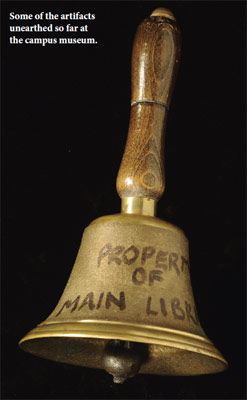|
February 2015

Issue Home >>
|

 University museums are common all over the world: there are over 80 in the UK alone, for example. At Mona, on the ground floor of the Vice Chancellery building, the UWI Museum displays the University’s rich history – but, inevitably, it’s mostly about the Jamaican campus. University museums are common all over the world: there are over 80 in the UK alone, for example. At Mona, on the ground floor of the Vice Chancellery building, the UWI Museum displays the University’s rich history – but, inevitably, it’s mostly about the Jamaican campus.
Here at St. Augustine, our predecessor institution, the Imperial College of Tropical Agriculture (ICTA), had envisaged a museum from its very inception. Early floor plans for the Administration Building included space for a museum. Sadly, it never materialized, and to date we have no Campus Museum, but the idea has always remained alive.
It was Deputy Principal Rhoda Reddock, while she was head of the then Centre for Gender and Development Studies, who took the initiative to get the ball rolling. Later, as Deputy Principal, she took up the idea again and was instrumental in setting up a working Museum Committee, which reports to her. It’s chaired by Dr Glenroy Taitt of the Alma Jordan Library and Mike Rutherford, who runs the Zoology Museum, is deputy chair.
The principal – though not the only – purpose of the proposed Campus Museum is to display and celebrate our rich history: the history both of our geographical space, and of the institutions which have found their home there. First, in the 1800s, there was the St. Augustine sugar estate; the Principal’s office building was the estate manager’s house. Then the colonial government bought the estate and established a demonstration farm and agricultural research station. It donated the land for ICTA, which opened its doors in 1922. And then, of course, with the merger of ICTA and the University College of the West Indies in 1960, the regional University established its second campus here.
Our Campus Museum will feature a permanent exhibition illustrating the history and pre-history of UWI, St Augustine. This will include documents, paintings and photographs, but especially physical objects (artifacts), the main feature of any museum.
We already have on campus several important museum-like institutions and collections. There’s the National Herbarium, which houses specimens of the plants (flora) of Trinidad & Tobago collected over a period of nearly 200 years. The Zoology Museum in the Department of Life Sciences is home to the Banwari Burial, the oldest human remains found in the West Indies, and a rich collection of animal specimens. The History Department’s Archaeology Centre has many Amerindian artifacts, and the Eric Williams Memorial Collection in the Library includes photos and artifacts and the Doctor’s reconstructed study. The Cocoa Research Centre manages an internationally known cacao germplasm collection, the International Cocoa Genebank, Trinidad.
So the foundations of a Campus Museum, which could be multi-site, already exist. These collections are highlighted in the Museums and Collections website which was launched in 2013 – check out the campus home page just after “Libraries”. In the absence of a physical museum, the website is an important form of outreach.
The Museum Committee is working hard to develop a historical collection: documents, but especially artifacts, which illustrate the history of the campus. The first phase included developing an acquisition or collecting policy (what kinds of objects we want to collect) and starting an inventory of objects already owned by UWI. Through student assistants in the summer of 2013 and 2014, inventories have been drawn up for several departments and units, as well as a partial listing of works of art owned by the campus. This work is ongoing, of course. Later, we will want to solicit artifacts and memorabilia owned by individuals, especially alumni and former staff – think of old ID cards, hall menus, sports gear and so on.
Naturally, the aim is to digitize as much as possible, to create a bank of digital images of interesting objects in the historical collection. This has already started; one especially fascinating object recently put online is the Visitor’s Book in the Principal’s Office. Going back to the 1940s, it’s amazing to see what a diverse collection of the Good and Great has visited our campus!
Of course, the ultimate aim is to have a building, or part of one, dedicated to the Campus Museum. One possibility is to house the Museum in an existing, older structure, perhaps dating from ICTA days (1922-60), so that the building as well as the contents reflect our evolution. A more ambitious (and expensive) dream is for a new, state of the art structure.

In addition to the permanent exhibition on the history of the campus, similar to the University Museum at Mona, temporary displays might be mounted from time to time on particular themes, to which the public and school groups could be invited. An art gallery and temporary art exhibition space would be a tremendous asset.
Of course, since this is a University Museum it should contribute to our teaching and research programmes, just as the National Herbarium and the Zoology Museum do now. When the Department of History introduces its graduate programme in Heritage Studies, it will find the Museum a valuable asset to planned courses on museum studies, heritage conservation and so on.
The Museum Committee wants to involve the campus community in its work. If you own interesting things related to the history of St Augustine, or if you know where such objects (or documents or pictures) may be located, or if you just want to help—please contact glenroy.taitt@sta.uwi.edu or mike.rutherford@sta.uwi.edu. They would love to hear from you!
Emerita Professor Bridget Brereton is a specialist in the Caribbean’s history. |





